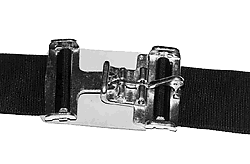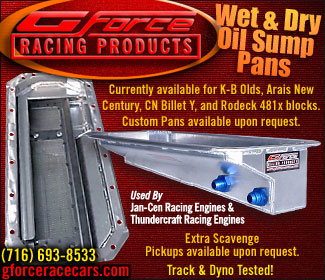
RELEASE HARDWARE
Latch mechanism or aircraft type "quick release"
are the two most common types of releases systems.
Latch assemblies are considerably lighter than
aircraft releases and they do not contribute
to any confusion when it comes to buckling up
or releasing the latch. If there is a drawback
to this type of mechanism, it is accidental
opening. Although this might be a remote possibility,
it can happen. Some manufacturers offer a revised
latch "bill" to solve this issue.
 |
Two systems that are currently
available are the conventional latch mechanism
like this or an aircraft type "quick release".
Basically, the latch mechanism (as shown
in this photo) is simple and extremely easy
to use. There's no confusion when it comes
to buckling up or releasing the latch. |
SHOULDER HARNESS CONFIGURATIONS
There are a number of different styles of shoulder
harnesses available. Included in this group
are the loop style, the twin style, and the
more traditional "Y", "H" or "V" configurations.
The correct attachment point for the shoulder
harness is immediately behind the driver. The
attachment point should then be between one
to four inches below the driver's shoulder line.
| There are many different
types of shoulder harnesses on the market.
One system is the twin style harness. Basically,
two single "belts" or harness's make up
the twin. Twin shoulder harnesses can either
be wrap-around mounted (to a roll cage back
brace) or mounted directly to the roll cage
brace, using bolt-in or snap-in hardware.
At the front, the twin harnesses fasten
to the latch mechanism, or in this case,
directly to the quick release. |
 |
The best shoulder harness arrangement is the
"twin" style. Two single "belts" or harnesses
make up the arrangement. The attachment is by
a wrap-around mount or by a
ADVERTISEMENT
 |
snap-in
mount on the roll cage brace behind the driver's
shoulder. The twin harness assemblies then fasten
to either the latch mechanism or the quick release
hardware.
The "H" style of harness is very similar to
the "twin" with one addition. The added piece
of webbing between the pair of shoulder harnesses
connects the respective halves of the twin assembly.
This keeps the harness straps parallel to each
other. Another style of harness sometimes found
in racing circles is the "loop". This harness
attaches to the roll cage by a slip-knot.
The worst possible shoulder harness arrangement
is a long "Y" configuration that mounts to the
floor immediately behind the driver. It's not
great because the webbing can stretch. The longer
the harness, the more the stretch, and the more
the stretch, the more danger a driver faces
in being forced forward during impact.
If the car is equipped with a shoulder harness,
it absolutely must be equipped with a suitable
anti-submarine belt system. At no time should
a race configuration shoulder harness be buckled
up without a proper anti-submarine belt.

|